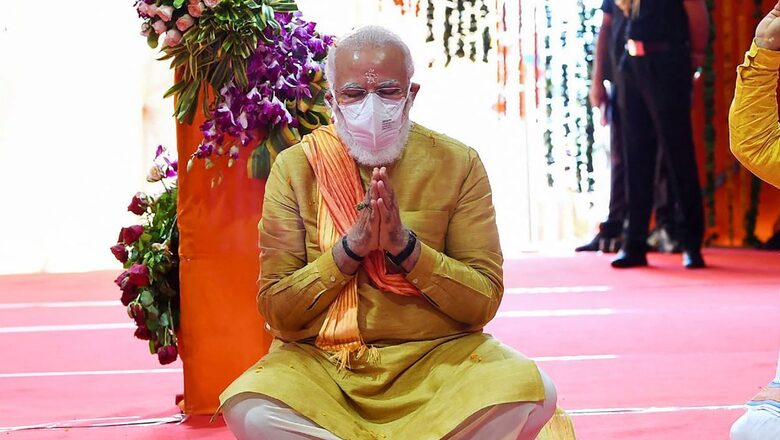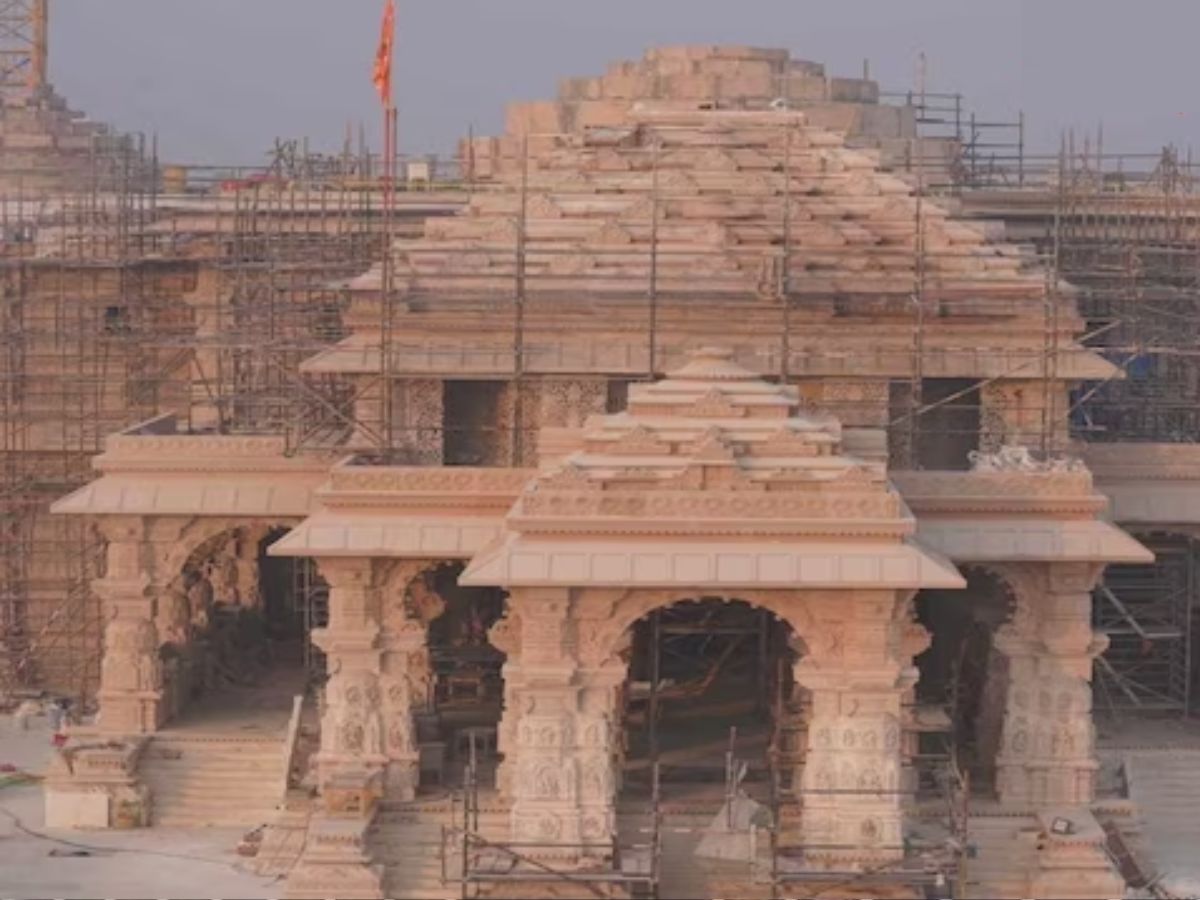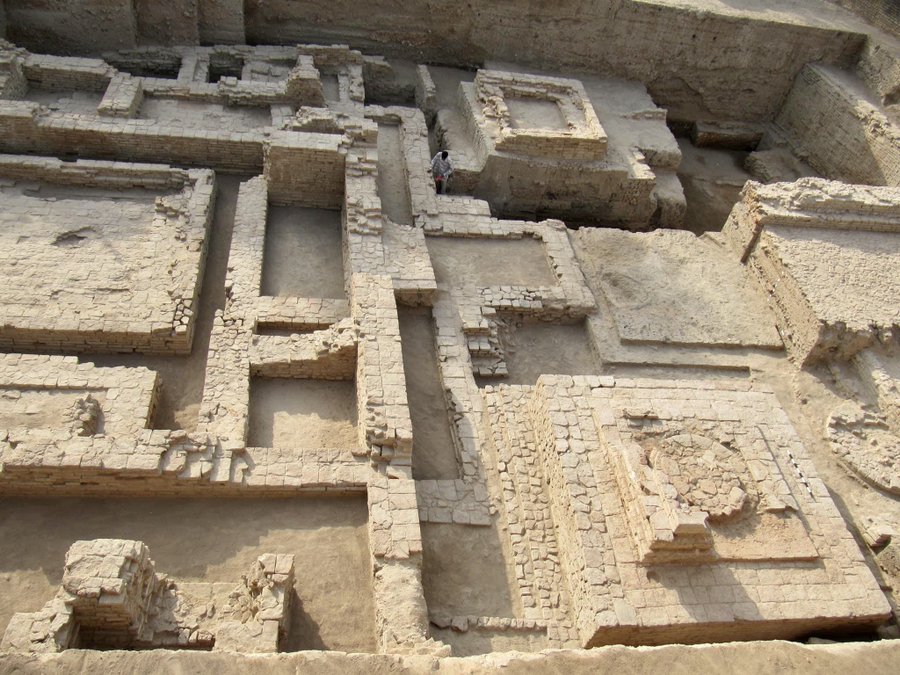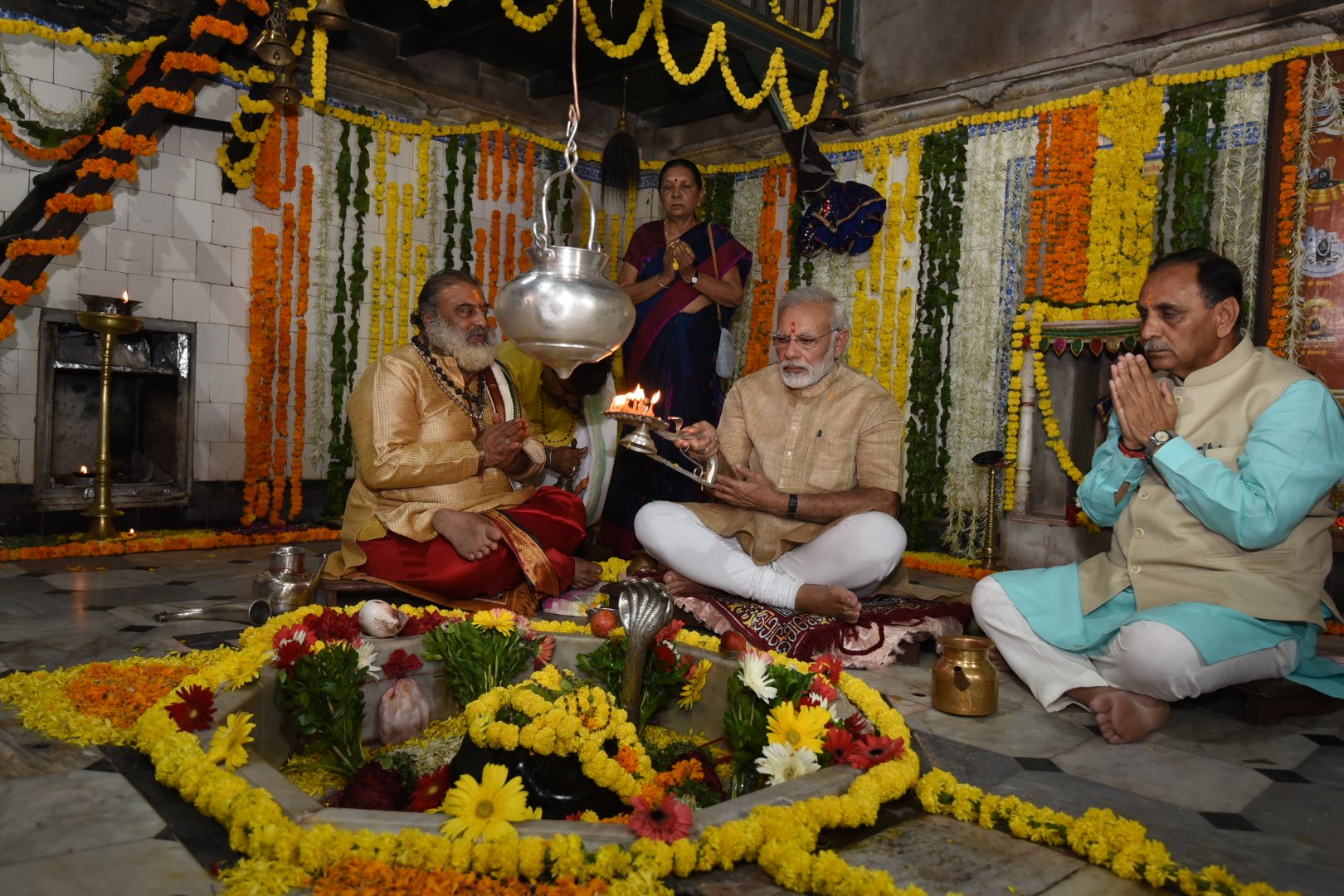
views
Years ago, before Narendra Modi became the chief minister of Gujarat, his devotion to Lord Ram manifested in the form of a short verse he penned.
राम
राम व्यक्ति को नहीं, वृत्ति को प्राप्त हुई संज्ञा है
राम हमारा चिंतन दर्शन, प्रीति प्रकृति प्रज्ञा है
राम चिरंतन जीवन मूल्यों का स्वर्णिम शिखर है
राम हमारी संस्कृति का सारस्वत हस्ताक्षर है
राम हमारा धर्म, हमारा कर्म, हमारी गति है
राम हमारी शक्ति, हमारी भक्ति, हमारी स्तुति है
बिना राम के आदर्शों का चरमोत्कर्ष कहां है?
बिना राम के इस भारत में भारतवर्ष कहां है??
On the letterhead of the Jammu and Kashmir unit of the Bharatiya Janata Party, Narendra Modi wrote this poem when he was not a part of government but the organisation.
The short poem is a testimony to what Ram means to Narendra Modi. Ram is not a symbol of politics to him. Understanding the essence of ‘Bharatiyata’ is impossible without Ram. Ram is the biggest symbol of India’s civilisation and bearer of the thousands of years old Sanatan tradition of the country. He is the epitome of whatever is great and good about this country.

This goes back to the time the Ram Janmabhoomi movement had gained momentum. The then BJP national president LK Advani had just ended his Rath Yatra from Somnath to Ayodhya at Samastipur. The then chief minister of Bihar Lalu Prasad Yadav had put brakes on it to prove himself a ‘messiah of Muslims’ and to play the politics of secularism. Back in the day, nobody knew how long the legal and political dispute over the Ram Janmabhoomi in Ayodhya would last.
At the time, who could have imagined that a magnificent temple for Ram Lala would one day be built in Ayodhya, or that Narendra Modi, who had such a big part in the Rath Yatra in 1990, would be the person to turn this dream into a reality. That not only would he become the prime minister but would also be part of the bhumi pujan and then consecration of the Ram temple in Ayodhya. But all of this happened. Soon after becoming the prime minister in 2014, Modi not only made successful efforts to resolve the centuries-old Ram Janmabhoomi dispute but also played a big role in the speedy completion of the temple.
How did all of this become possible? How did Modi manage to bring Lord Ram, the biggest symbol of India’s civilisation, to the threshold of the grand temple built on his birthplace to house him there in the form of Ram Lala?
Have temples been a means to spiritual search and national consciousness for Narendra Modi? Did he receive these values as a child? Did he learn social service from religion and spirituality? Is the construction of the Ram temple just a religious building exercise for Modi or an opportunity to establish the ancient values of India’s civilisation and culture on the world stage with full force? Will the completion of the Ram temple take Hindu Sanatan culture to greater heights?
To find answers to all these questions, we have to look into the pages of Modi’s life that are connected to spirituality, temple, and soul-searching. Only the spiritual aspect of his personality has the answers. Modi usually speaks little about this part of his nature. But a close examination of his life reveals many clues. This is an attempt to determine when the seeds were sown in Modi’s mind that led to India’s civlisational values and unique identity being firmly planted on the world stage in the 21st century.
Is Modi’s efforts in getting the Ram Mandir built part of a political ploy to reach out to the majority Hindu votes or is he a sanyasi at heart and a politician by profession?
Modi, temples and spirituality (part 1)
At the age when children spend a lot of time playing around, Modi used to roam temples and interact with saints. Growing up on the streets of the historic city of Vadnagar in Gujarat, this child was looking for happiness in the service of cows and the destitute.
The small town of Vadnagar in the Mehsana district of Gujarat has been famous since ancient times in terms of art, religion, and culture, bearing different names in different eras and with religious significance for Hinduism, Buddhism, and Jainism.
In the Skanda Purana, Vadnagar is described as Chamatkarpur, while in the Mahabharata, it is called Anartapur. Around the first century, Vadnagar was so prosperous and the people here were so happy that Anartapur came to be known as Anandpur. An inscription of Kshatrapa Rudradaman-1 also mentions Vadnagar as Anartanagar. The famous Chinese traveller Hiuen Tsang who visited India around the seventh century has also given a detailed description of Vadnagar in his travelogue, referring to it as Anandpur.
The Directorate of Archaeology, Gujarat, and the Archaeological Survey of India (ASI), a central government agency, have also carried out extensive excavations in Vadnagar over the past two decades to delve deeper into the history of this place, which has borne different names at different times. The evidence collected by these agencies so far shows that this town has had continuous human settlement for the past 2,700 years.

Vadnagar was fortified by walls since ancient times. And the signs are still there in the form of some doors and remnants of a few walls. To give a sense of the historicity of the place, there are also Kirti Torans, the design of which resembles the work at Rudra Mahalaya of Sidhpur. All these are unparalleled landmarks of the centuries-old rich architectural heritage of India.
There is no dearth of temples in the town. The most famous, the Hatkeshwar temple, is the reason the Nagar Brahmins of Vadnagar greet each other with “Jai Hatkesh” wherever they are in the country or the world. Famous ponds such as Sharmistha pond and Gauri kund are mentioned in all literature and religious texts. Most of the areas in the city are either named after the temples and gates or after the different castes and communities living here. In Vadnagar, there are people of all castes like Brahmins, Patels, and Thakors, as well as Muslims in large numbers.
When India became independent on August 15, 1947, Vadnagar was part of the princely state of Baroda. In less than two years, the princely state of Baroda was merged with the Bombay Presidency, on May 1, 1949, for which the Instrument of Accession was signed by Maharaja Pratapsinh Gaekwad, the then ruler of Baroda, and VP Menon, representing the Government of India. Vadnagar then became part of Bombay Province and later part of Gujarat after it came into existence on linguistic basis on May 1, 1960.
On September 17, 1950, early morning, Narendra Modi was born in Vadnagar, a town renowned for its rich history and cultural legacy. Three more children had already been born to Mother Heeraba: two sons, Sombhai and Amritbhai, and a daughter, Sharda. Three children, Prahladbhai, Vasantiben, and Pankajbhai, were born after Narendra Modi.
Shardaben passed away young in Vadnagar after being born at Heeraba’s paternal place Visnagar, in the house belonging to her father Hargovind Das Modi. It used to be customary for women to give birth to their first child at their parent’s home. She was the oldest child of her parents. After her came six sisters and three brothers: Babubhai Modi, Jayantilal Modi, and Harshadbhai Modi. Like Heeraba, Damodardas Modi was also the oldest child of his parents, born on June 11, 1921. He was followed by five brothers and a sister.
Narendra Modi’s Sanatani family was spiritually and religiously conscious. They lived in poverty but were rich culturally. His mother Heeraba was illiterate, but his father Damodardas Modi had studied till class 8. Returning home in the evening after closing the tea stall at Vadnagar railway station, he used to read the Ramayana and Mahabharata to his wife and children at night.
A different child
All the members of the family went to the temple. Next to their residence in Modi Ode was the Omkareshwar Mahadev temple, famous as the temple of Giripuri Maharaj. Kids playing in the area would often reach the temple about 200 metres away and would eagerly participate in the morning or evening aarti events. Narendra Modi himself enjoyed playing the naubat (ceremonial drum) aside from clapping during the aartis.
When Modi visited Japan for the first time as prime minister in 2014, he engaged in a jugalbandi with an accomplished artist in the field of drumming. The scene in Tokyo on September 2, 2014, was no less than a pleasant surprise for the diplomats and locals of Japan standing there. At that time, nobody would have thought that Modi, who had made it big on the stage of diplomacy, would so effectively use his childhood skill as part of cultural diplomacy.
In the 1950s and 60s, the Modi family also had a cow, which Narendra Modi had the responsibility of bathing daily. Since childhood, Modi used to take this cow to the Sharmistha pond. He would bathe the cow first, secure it, and then take a bath, clean his clothes, and go for a swim. This habit of cow service from childhood was also Modi’s introduction to India’s culture in which the cow has the status of mother or Gau Mata, and her service is considered pious and holy.
Modi, who served the cow every day, was equally passionate about serving saints and seers. A great example of this was seen when Chandrikaben, the younger sister of mother Heeraba, was going to be married and the entire Modi family was preparing to go from Vadnagar to Visnagar. Narendra Modi was studying in class 7 at the time. On the day of going to Visnagar, all the other family members were full of enthusiasm, but he flatly refused.
Mother Heeraba could not understand what had happened to her son. Often going to family events, especially a wedding, means an opportunity to enjoy various delicious dishes. For the Modi family, where poverty meant having halwa-like lapsi in the name of sweets, why turn away from the prospect of wedding delicacies?
At home, the children were usually given only bajra roti and kadhi. When a guest came to the house, wheat roti and vegetables were made. The leftover bajra rotis made in the day were heated in the evening and had with tea. So Narendra Modi refusing wedding delicacies and potentially earning the wrath of his aunt surprised everyone.
His mother asked her third son the reason for the refusal. Narendra replied that if he went to the wedding, there would be no one to serve the sadhu who had been doing sadhana for the past several days in the Omkareshwar Mahadev temple, and had coated his body with soil to grow sorghum. At that time, sadhus and sanyasis used to practise severe penance, sadhana, hatha yoga. If sorghum is grown on the body then you cannot sit up, you have to lie down and someone else has to bring you food and water. Narendra Modi had taken responsibility of this service for the sadhu and he prioritised it over wedding festivities.
Mother Heeraba tried to convince her son several times, but Narendra Modi was adamant. The rest of the family went to Visnagar, and he stayed back alone in Vadnagar to serve the sadhu. This was an indication of how much interest Modi had developed in religion, spirituality, temples and sanyas since childhood. He was studying in class 7 at that time.
Focus on education and culture
As far as education was concerned, for Modi, schools were also temples of culture and values. The name of the school from which Modi studied from first to seventh was Darbar School, which was established in 1881 during the Gaekwad Raj, under the reign of Sayajirao Gaekwad III, the great and reformist ruler of Baroda. It was Sayajirao who, for the first time in the country, made primary education compulsory for all children in the age group of six to 14 years, starting from Amreli, the most backward area of his princely state. Beginning with ten selected villages of Amreli in 1893, Sayajirao made education up to class 6 compulsory in all areas within his princely state by 1906. Primary education was made both free and mandatory so that children could learn and poverty could not prevent them from doing so. Not only this, about 1,500 libraries were also opened to inculcate the culture of education in children, which were present in every big town of the state.
A little over a year before Modi’s birth, the princely state of Baroda had merged with the Bombay Presidency, but the pillars of the Gaekwad education system, the school, and the library were still standing and functioning well in Vadnagar. Modi not only studied in the Darbar School till class 7 but also made good use of the library of Vadnagar established in the Gaekwadi Raj. Sitting in this library, Modi read in detail for the first time about his inspiration, Swami Vivekananda.
First contact with Sangh
These were the school days of Modi, around the time when the Rashtriya Swayamsevak Sangh was also constantly expanding its activities, in a bid to draw students and the youth. The year Modi was born, in 1950, the first all-India representative assembly of the Sangh met. After that, in 1952, the reins of the campaign for cow protection were taken by the RSS. In 1953, a campaign was launched for the abolition of Article 370 from Jammu and Kashmir, in which the then national president of the Jan Sangh, Syama Prasad Mookerjee, sacrificed his life and thousands of Sangh volunteers joined that movement, raising the slogan of “Ek Desh Mein Do Vidhan, Do Pradhan, Do Nishan, Nahin Chalega Nahin Chalega”. Eknathji Ranade, who was elected Sarkaryavah of the Sangh in 1956, formed a committee in 1963, which was to not only build the Vivekananda Memorial in Kanyakumari, but also to organise Vivekananda birth centenary celebrations across the country. Ranade himself became the secretary of the organising-cum-construction committee.
The Sangh engaged students and youth as part of the Swami Vivekananda birth centenary celebrations across the country. The biography of Swami Vivekananda and his thoughts were translated into every language and made available to the people. Modi also read about the life and philosophy of Swami Vivekananda in his mother tongue Gujarati. That was when Modi started going to the Vadnagar shakha as a child volunteer, and here he met veteran RSS pracharak Laxmanrao Inamdar for the first time, who not only later made him a pracharak of the Sangh but Vakil Sahab, as Inamdar was also known, became his guide and mentor.
School days of ‘ND’
One of his teachers, Ishwarbhai Patel, who taught mathematics at the BN High School in Vadnagar, got an indication of how important the Sangh shakha was to Modi. After studying from class one to seven at Darbar School, which later came to be known as Kumar Shala No. 1, Modi joined BN High School in class eight in 1963.
Ishwarbhai Patel was active in the Congress Seva Dal at that time, while his student Modi used to go to the Sangh shakha. The Congress was quite strong in Gujarat at that time, just three years after the state was formed. But the teacher and his student would often come face to face in the field of sports with the teams of Sangh and Seva Dal competing against each other. However, Modi didn’t get influenced by Ishwarbhai to leave the Sangh and join Seva Dal. Ishwarbhai shared his experiences on November 27, 2005, at an event organised by Modi to honour his teachers. On that day, 28 such teachers, who had taught Modi in Vadnagar, had gathered at the Gujarat College ground in Ahmedabad and narrated their memories from Modi’s childhood and school days. Everyone believed that patriotism was innate in Modi from childhood and the connection with the Sangh was deep. Everyone remembered how ‘ND’, as he was known by many in his childhood, used to run towards the Sangh branch and temple after school.
Along with being actively involved in socio-religious activities, ND also attended school, the library, NCC training, and Sangh shakha activities. He was a worshipper of Shiva and Shakti at the Hatkeshwar temple, and during Navratri, would do so through through Garba. Modi enthusiastically performed Garba in his school days. The air of Vadnagar was filled with music. After all, this was also the town of sisters Tana and Riri, who would outdo Tansen, one of the nine gems in Akbar’s court, when it came to singing. When Akbar heard of their fame through Tansen and wanted to invite them to his court, these sisters decided to give up their lives but chose not to leave Vadnagar and go to Agra. They would sing in the praise of the gods and goddesses of Vadnagar and were not prepared to do so for money and fame in the court of an emperor. The children and youth of Vadnagar have been hearing the story of Tana-Riri’s dedication and singing from their elders for years. Modi also heard it in his childhood and took inspiration, to remain firm in his beliefs.

Religion and social service
It was in Vadnagar that as a teenager Narendra learnt how to use religious occasions for social service. Vasantbhai Parikh was a famous doctor there. Born in 1929, Vasantbhai studied medicine at the Jamnagar Ayurvedic College and then, after a short stint in government service, started the Nagrik Mandal Hospital in Vadnagar with his friend, Dr Dwarkadas Joshi. The patients were never asked for any fees; whatever they gave was accepted. These doctors would go even to far away Bihar and set up eye camps and perform cataract surgeries. Also, be it flood or drought, wherever there was a crisis anywhere in the country, Dr Parikh was at the forefront of providing help and sending relief materials and aid money.
Appreciating the social service of Dr Vasant Parikh, the locals also elected him their MLA in 1967. On his appeal, when Modi was studying in class 11, he along with his friends had set up a tea stall at the Janmashtami fair at Gaurikund. All the necessary materials were brought by the friends from their homes or bought with their pocket money. Modi had received only one rupee from his father, but he had brought a stove and bedsheets from home. He spent the entire day selling tea with his friends and donated whatever he earned to Dr Parikh. This help came in handy for the people of Bihar who were affected by both drought and floods during 1966-67.
Modi was also influenced by social reformer Pandurang Shastri Athawale in his childhood. Not only did he visit Pandurang Shastri at Parmanand Gandhi’s house in Vadnagar but also encouraged his youngest brother Pankaj Modi to join the satsang. Once Pankaj went to the place of satsang and quietly slipped away, and Narendra Modi reprimanded him. Modi was very interested in the social reform work of Dada Athawale.
Narendra Modi’s time in Vadnagar, till the age of 17, was spent like this, in the midst of temples, schools, Sangh shakha, social service, devotion, and adoration, learning not only about the country and society but also great heroes, such as Vivekananda, Shivaji, Maharana Pratap, Sardar Patel, and Subhas Chandra Bose.
But his mother had something on her mind. When Modi was at school, a seer had once read his palm and said that either this boy would become a sanyasi or a great revered personality. Seeing her son spending so much time with saints and in temples scared his mother, and she was worried that he would become an ascetic.
(Coming up in next edition: On the way to sanyas)



















Comments
0 comment